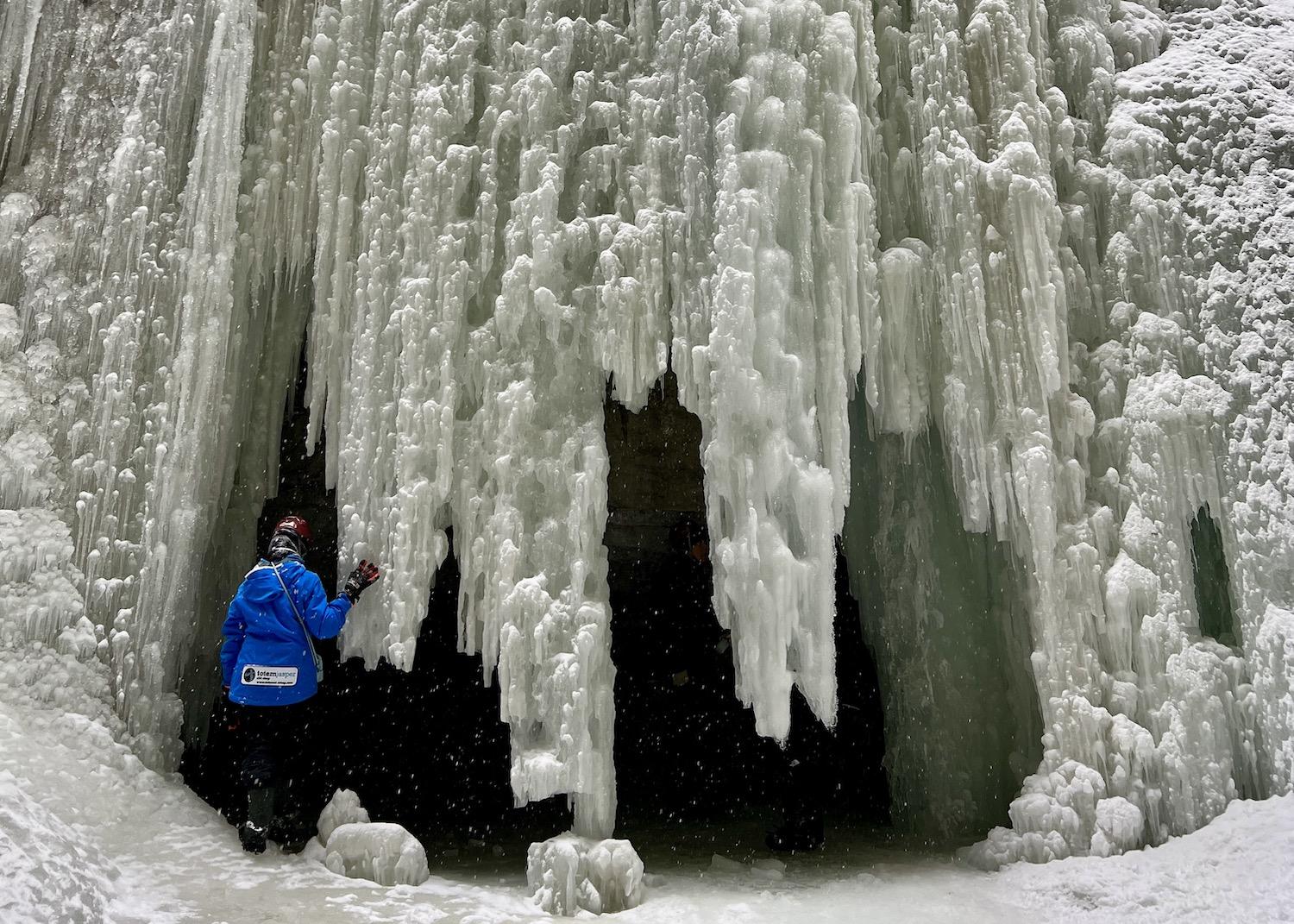
Entering a small cave with an icy overhang on the Maligne Canyon Ice Walk in Jasper National Park/Jennifer Bain
As promised, Maligne Canyon wraps us around its icy finger with its spellbinding frozen waterfalls, giant icicles and frosted limestone walls.
Darting into an ice cave through an opening in the icicles is a quick and carefully controlled thrill. I chicken out in the face of an optional natural ice slide, but there’s only one way through a narrow gap between rocks and that’s straight down on a “bum slide.”
Kitted out in borrowed ice cleats, insulated rubber boots and a helmet, I repeatedly give thanks for the chance to stand in the deepest accessible canyon in Jasper National Park one memorable March day near the end of icewalk season.
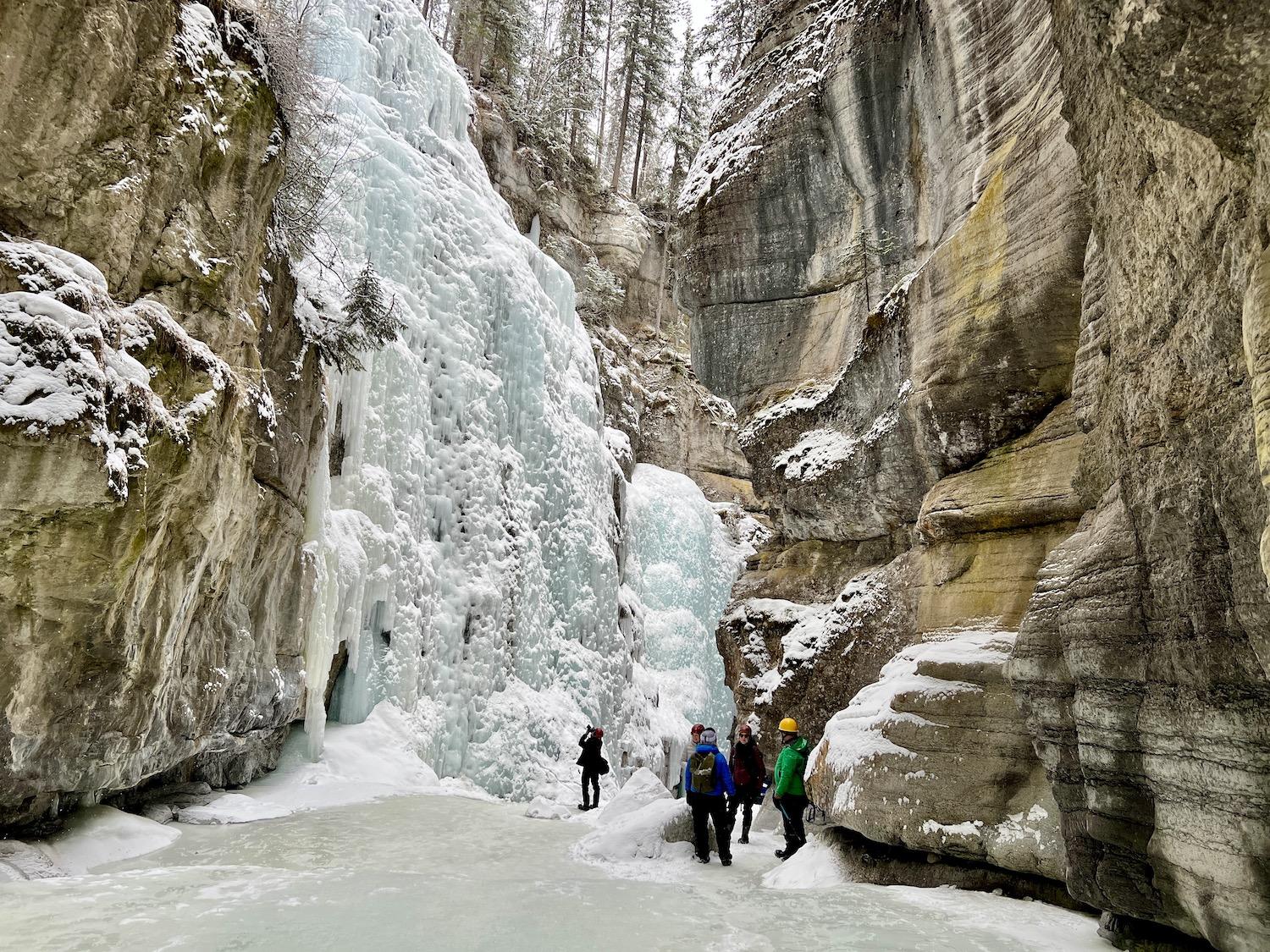
A guided icewalk through Maligne Canyon in Jasper National Park with SunDog Transportation and Tours/Jennifer Bain
Jeff Hanson, a longtime guide with SunDog Transportation and Tours, does such a good job of keeping our group safe that it’s hard to believe this canyon was named for the French word that means “evil” or “wicked.” Then again, Pierre-Jean De Smet, a Belgian Jesuit missionary, called this place “maligne” when he struggled to cross the treacherous river in 1846 with his horse. Who knows what he would have said had the river been frozen.
“The canyon’s always changing and it’s really interesting,” says Hanson.
The last time I visited this Alberta park's famous canyon was in the first year of the pandemic when there was just a sprinkling of snow and it was that awkward time between fall and winter. Alone, I hiked the shortest loop — which had temporarily been declared a one-way trail — before a Jasper Dark Sky Festival dinner at the Maligne Canyon Wilderness Kitchen.
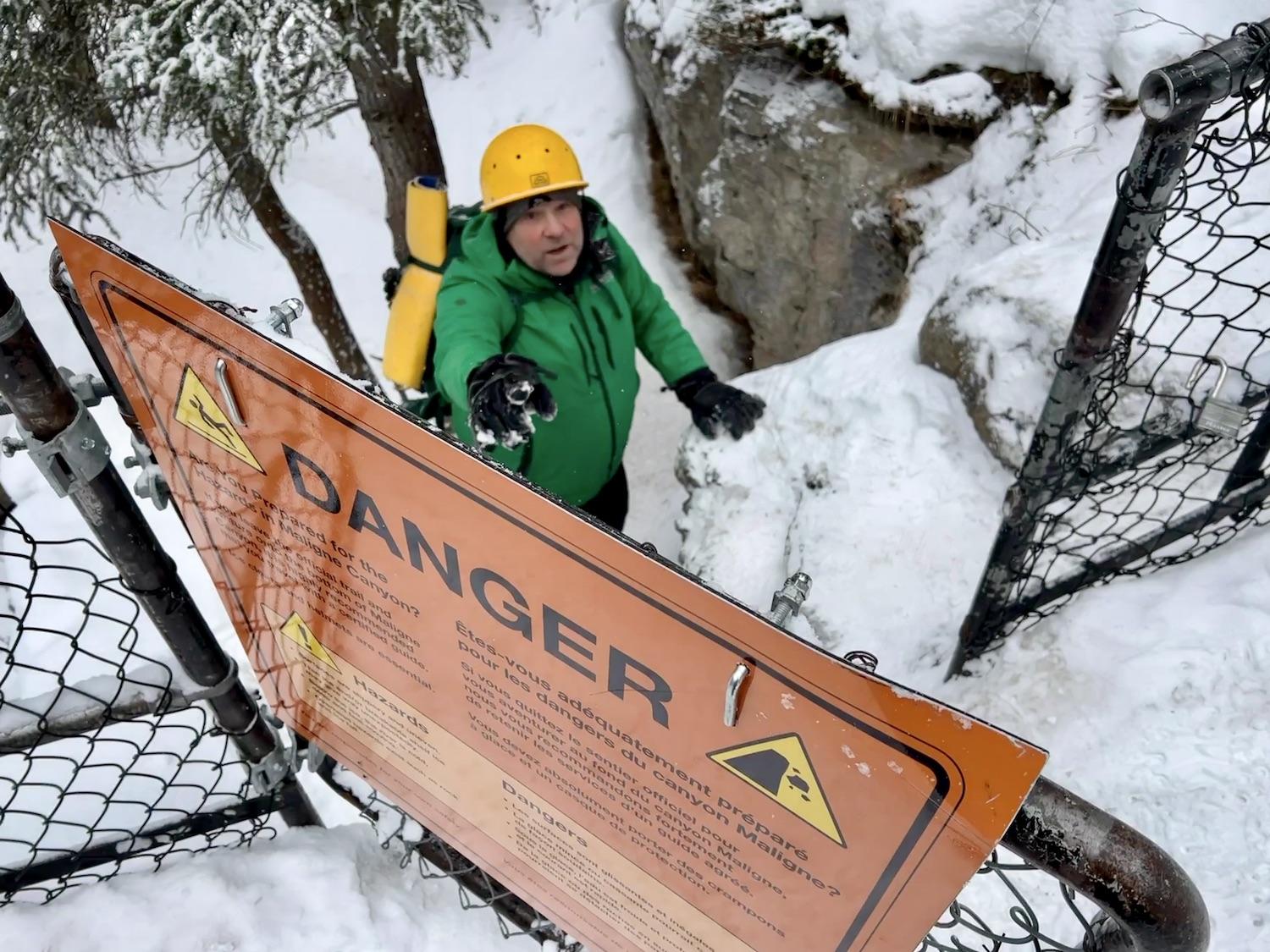
SunDog Transportation and Tours guide Jeff Hanson has the key for the gate that takes you off a marked trail to the Maligne Canyon floor in winter/Jennifer Bain
It’s a different story in winter. Parks Canada strongly recommends you hire a certified guide to safely walk the canyon floor. That’s how I find myself on SunDog’s Maligne Canyon Icewalk tour covering almost 4 kilometres (2.5 miles). The tours (up to 3.5 hours when you factor in travel time) run at the whim of Mother Nature, and this year that meant from mid-December to early April.
It's a warmer-than-it-sounds minus 10C (14F) as I slip fleece and waterproof pants over my base layer. A few degrees colder and snow pants would be mandatory. The black bears are hibernating and so the biggest potential hazard is apparently people who don’t slip icers over their boots for better traction.
“There are a couple of pinch points,” explains Hanson. While three companies are allowed to guide icewalks in the park, random unprepared people come on their own, and the last thing we need is someone tumbling ahead of us on the trail and knocking us over like bowling pins.
“We’re going to start at the top of the canyon and it’s basically downhill,” Hanson explains. “Our bus will be waiting for us at the end.” How cush is that?
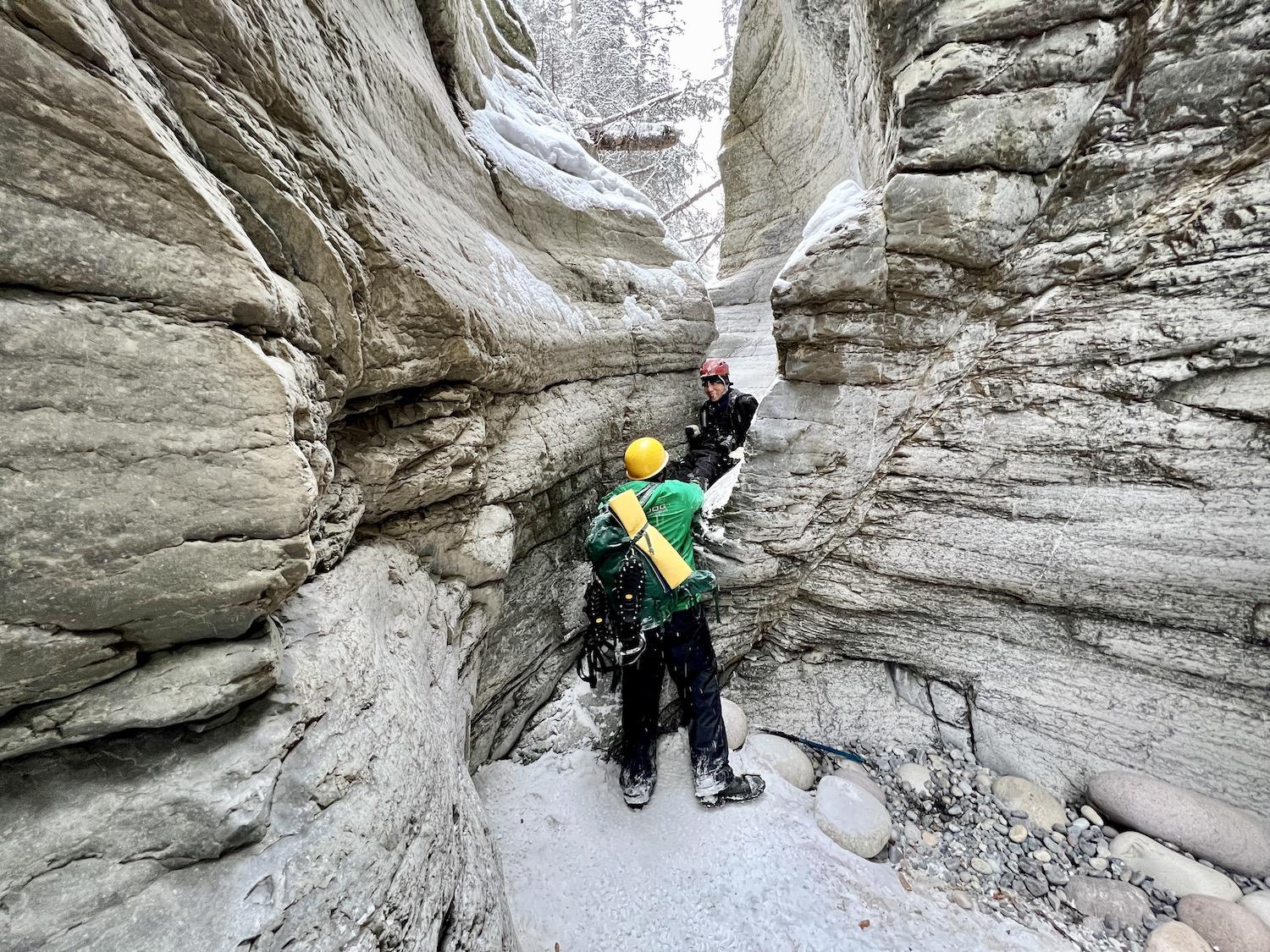
You have to sit down and slide between these rocks at one point during the Maligne Canyon icewalk/Jennifer Bain
At roughly 11,000 square kilometres (4,200 square miles), Jasper is the world’s second largest dark sky preserve and the largest national park in the Canadian Rockies (and second most popular after Banff National Park). It’s also home to Jasper townsite and its population of about 4,700.
The name is a nod to the area's fur-trading legacy and North West Co. voyageur and post manager Jasper Haws. Born in 1770, Haws was uprooted from his Maryland home during the American Revolution and taken to Canada by his United Empire Loyalist parents. From 1815 to 1821, he commanded a trading post dubbed “Jasper’s House." He also married an Iroquois woman and had five children.
When Jasper Forest Park was created in 1907, the name Jasper was chosen because of its historic association with the area. The name was later adopted by the townsite in 1913. A half-hour’s drive from Maligne Canyon, Jasper House National Historic Site boasts a commemorative plaque, viewpoint and clearing with the footprint of the old log buildings.
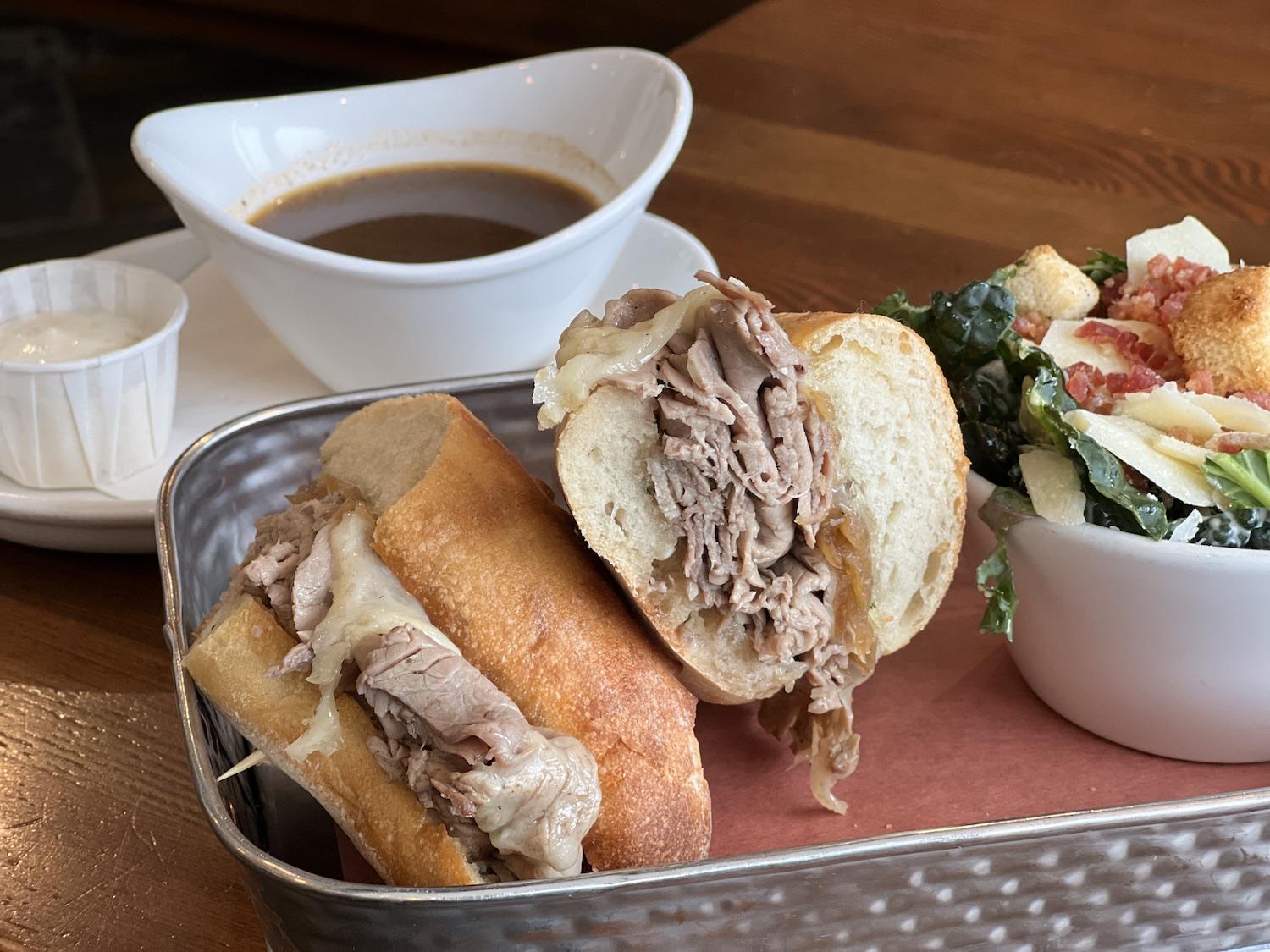
To fortify yourself before a Maligne Canyon icewalk, try the beef dip (roast beef au jus with Swiss cheese and caramelized onions) at Jasper Brewing Co./Jennifer Bain
Before the pandemic, Jasper — which calls itself the cabin capital of Canada — drew almost 2.5 million visitors a year and it's still making its way back to those numbers. Summer in the mountains needs no explanation. Winter visitors ski at Marmot Basin, snowshoe, cross-country ski, fat bike and hike.
With a private cabin at the Fairmont Jasper Park Lodge as my base for two nights, I get to swim in the heated outdoor pool while it’s snowing. Before the icewalk, I pop into town for an Alberta beef dip at the Jasper Brewing Co., which opened in 2005 as Canada’s first national park brewery.
SunDog shuttles me between my hotel and Maligne Canyon which, geologists will point out, is technically a gorge because it’s a narrow, slot-like feature carved in the floor of a u-shaped valley.
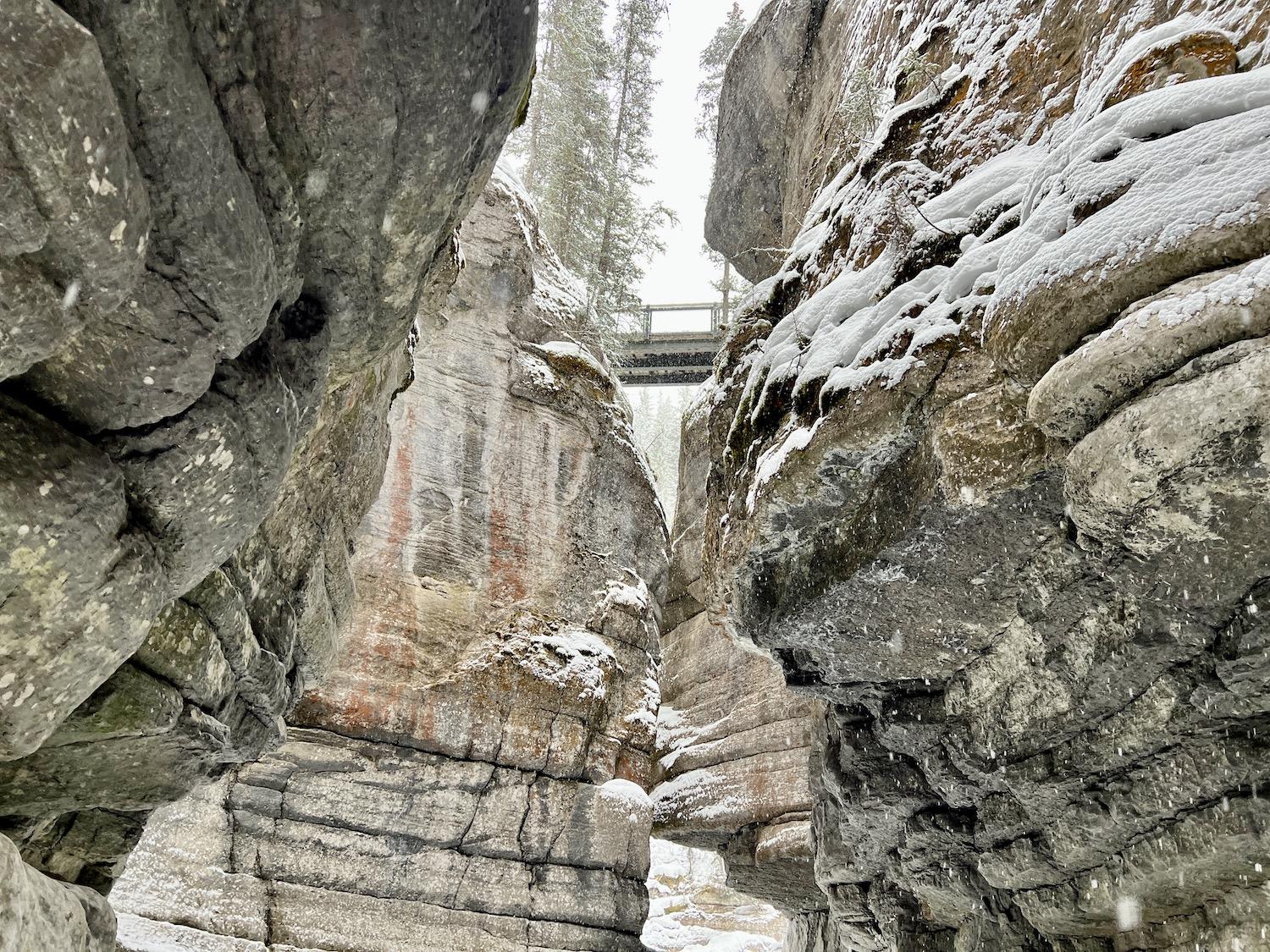
From the Maligne Canyon floor in winter, a view of one of the historic bridges/Jennifer Bain
Parks Canada has created the self-guided Maligne Canyon Trail. Water gushes from springs along the way. Interpretive signs explain how the canyon connects to Medicine Lake by an unusual cave system. There are six historic bridges, built between 1914 and 1928. We walk over the gorge on the first three, under the fourth, and then across the fifth to the parking lot where our bus is waiting (the sixth bridge is out of the way). We also walk on boardwalks, snow, ice, snow-covered rocks and a frozen log bridge.
The trail traces the canyon along limestone cliffs, roughly 50 metres (164 feet) above Maligne River, to its lower riverside. “No one knows how much deeper the canyon gets each year but a good guess would be a fraction of a millimetre,” a sign theorizes. “Multiply that by thousands of years and the result is spectacular.” Waterfalls, fossils, potholes, underground stream outlets, raven nests, rare black swift nests, lush plant life and chockstones are just some things that can be seen in the canyon, depending on the season.
The biggest waterfall, Hanson says with affection, is called the “Queen.” He shows us a chockstone — a boulder wedged across a narrow portion of the canyon. He finds a gastropod embedded in the rock, and I read how fossils show that the limestone bedrock here belongs to the Devonian geological period (366 to 362 million years ago), and how this area was likely once covered by a large, shallow inland lake.
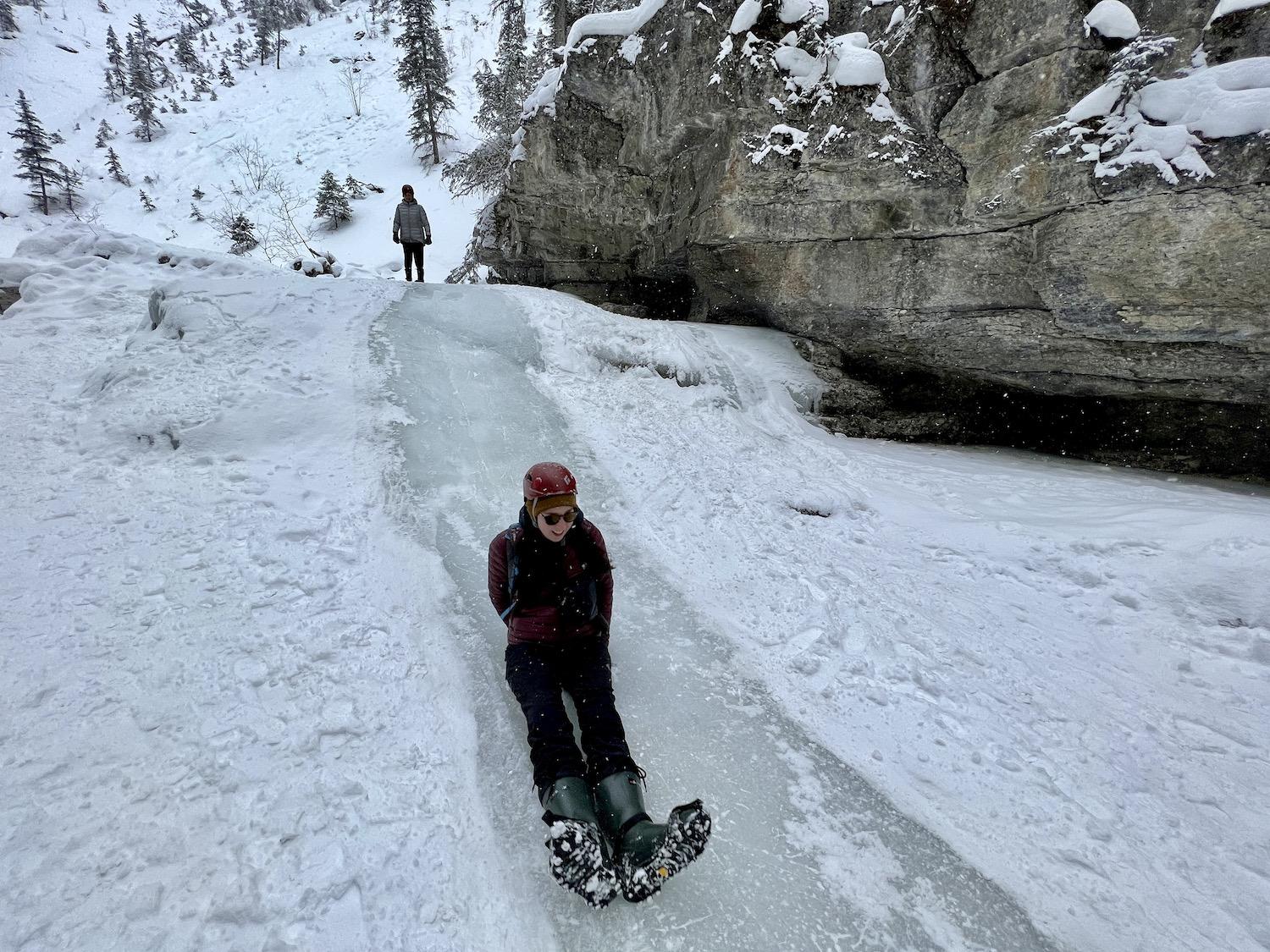
Maligne Canyon is constantly changing in winter, but on our visit there was an ice slide/Jennifer Bain
We come to a locked gate, but Hanson has the key. The fence is mangled where people have twisted it back to hop through, and there's a sign asking if you know what you're getting yourself into. To leave the official trail and venture onto the bottom of the canyon, Parks Canada warns, you must have ice cleats and helmets and should travel with a certified guide. Ice can be thin, "covering deep pools of extremely cold water or nothing at all." Surfaces are slippery and uneven. Overhead hazards include rock and ice fall.
Back when there was only a warning sign here and not a gate, Hanson recalls, some visitors would fall and get hurt in the canyon and then insist they thought they were following the trail. Now there’s no way to deny the warnings and people have to take some responsibility for their actions.
We only have to share the canyon with a few other guided groups today.
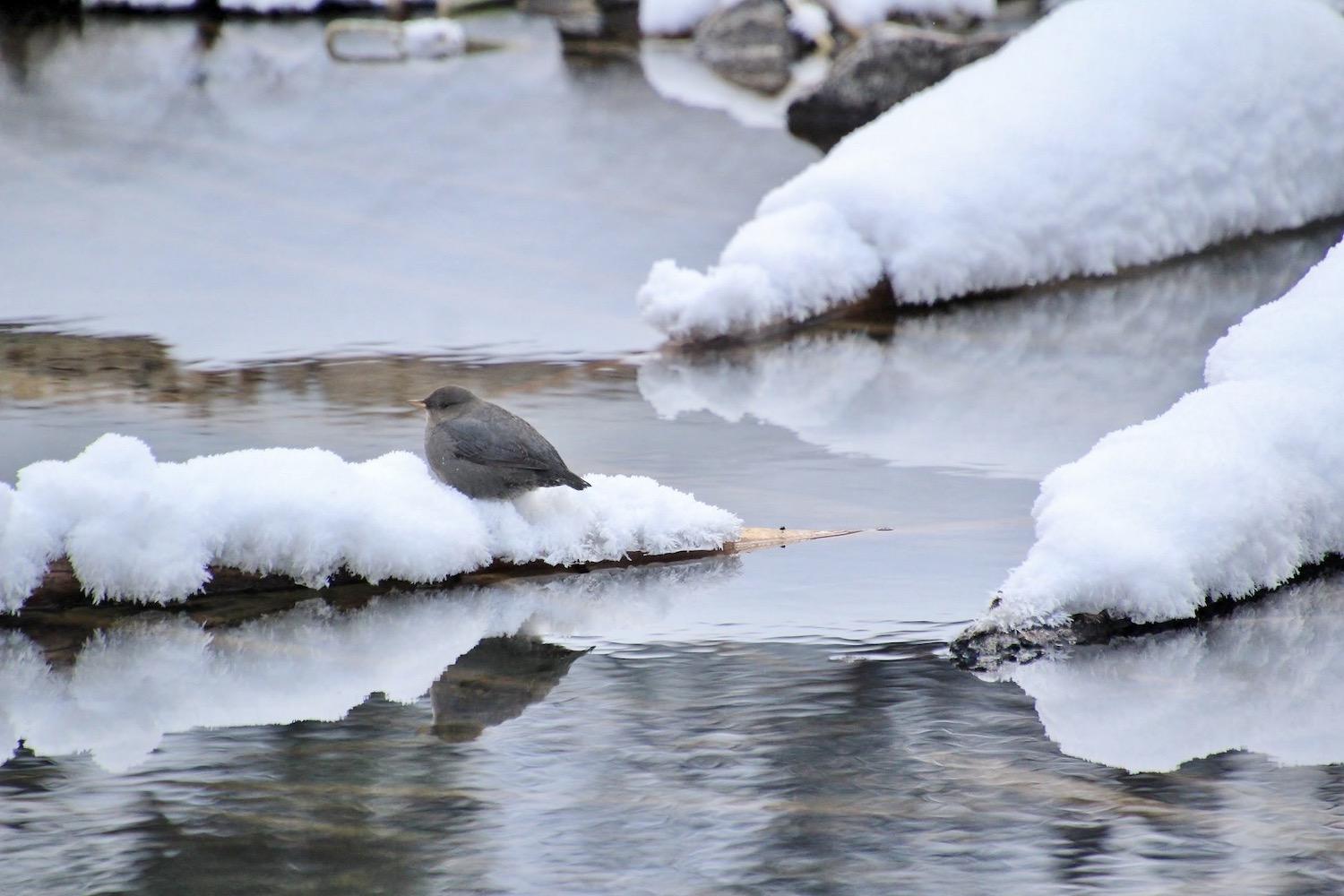
American Dippers, North America's only truly aquatic songbird, frequents the waters of Maligne Canyon in Jasper National Park/Kevin Gedling
With so much jaw-dropping natural beauty to take in, I'm not really here to spot wildlife although I read how deer, American marten and bighorn sheep live here, and we spot elk on the road.
It's not the right time of year to look for the elusive Black Swifts that build nests under the overhangs in the canyon. But I'm thrilled to spot my first American Dipper hopping on rocks in a shallow but fast-flowing part of the Maligne River just before the Fifth Bridge.
North America’s only truly aquatic songbird is a feisty thing, and it alternates between manically bobbing up and down and then plunging in the icy water to find aquatic larvae and insects, apparently "flying" underwater. Dippers, explains the Cornell Lab's All About Birds, have a low metabolic rate, extra oxygen-carrying capacity in their blood, feathered eyelids and an extra thick coat of feathers to help them survive in cold winter water.
For my final few Maligne Canyon moments, I forget about the oversized and otherwordly ice formations and stand mesmerized by this tiny, slate-grey beauty.
While You're In The Park:
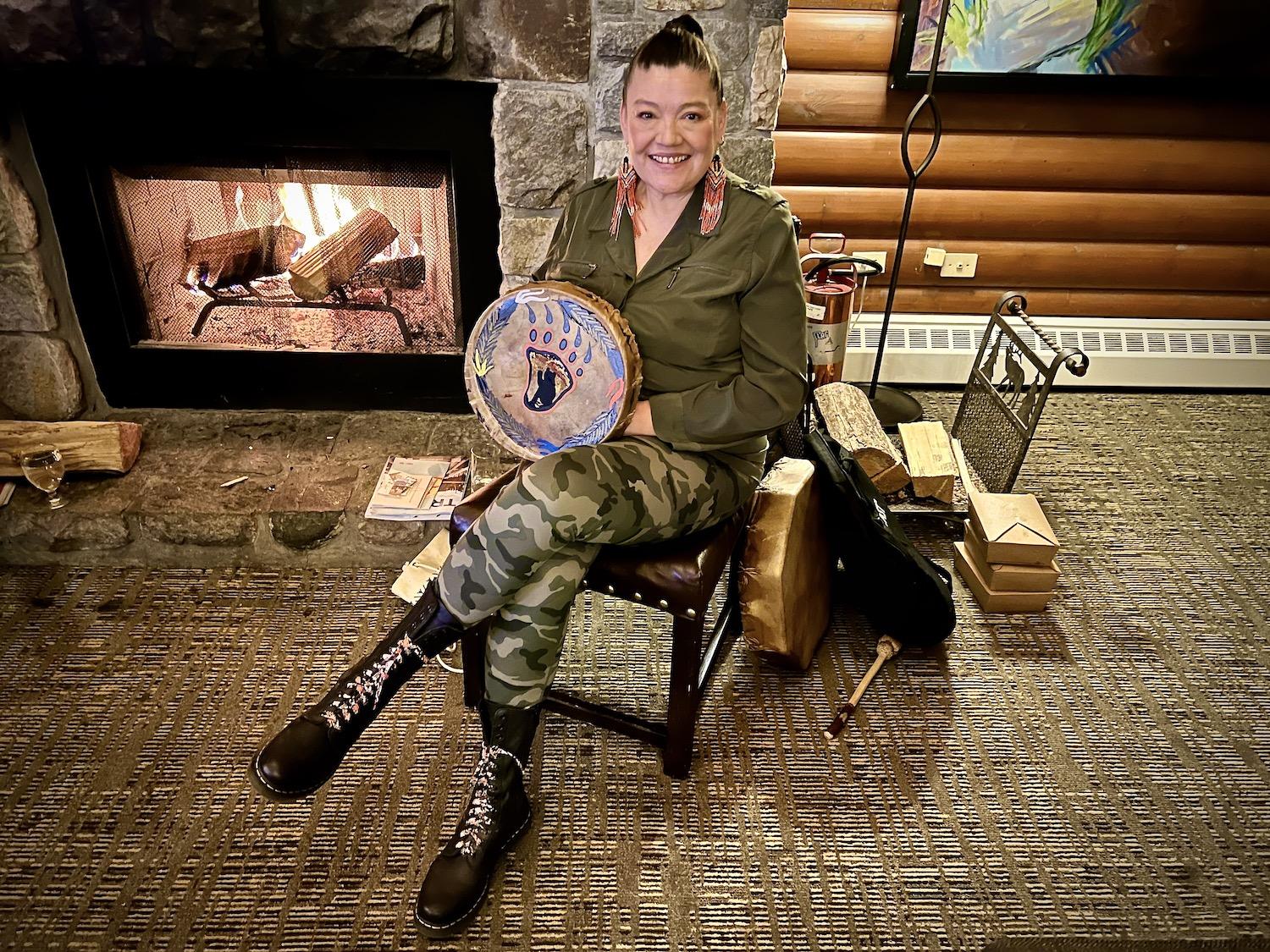
Matricia Bauer, founder of Warrior Women, visits Fairmont Jasper Park Lodge's Milligan Cabin for a fireside chat that includes singing, drumming, storytelling and sharing.
For 20 years, Matricia Bauer of the Sturgeon Lake Cree Nation has run Warrior Women, a collective of Indigenous women who drum, sing and educate others about their culture. I've seen Bauer several times in Jasper. During the dark sky festival, she appeared outside Maligne Canyon Wilderness Kitchen and later outside the Jasper Park Information Centre National Historic Site to share an Indigenous perspective on the skies. And on my recent March visit, Bauer came to the Fairmont Jasper Park Lodge for one of her "Fireside Chats." This time the theme was "circle of support." She also does plant walks in and around Jasper.


